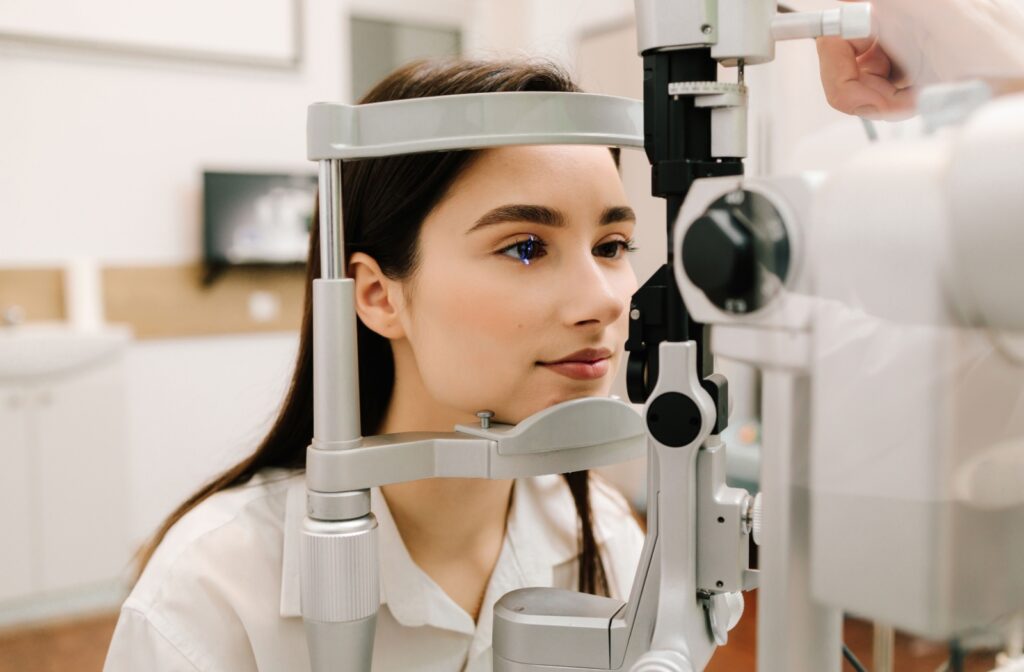If you’ve ever had an eye exam, you might remember the bright lights, letter charts, and perhaps the part where your pupils were dilated with drops. It’s a common part of many comprehensive eye exams, but it often leaves patients wondering: Do they always dilate your eyes for an eye exam?
The answer is no, not always. Whether or not your eyes are dilated depends on your personal eye health, risk factors, and the type of exam you’re having. In this blog, we’ll break down when dilation is used, why it matters, and what alternatives exist.
What Is Eye Dilation?
Eye dilation is a process in which your optometrist uses special eye drops to enlarge your pupils. This allows them to get a better view of the internal structures of your eye, including the retina and optic nerve. With your pupils widened, your eye care provider can more easily detect early signs of conditions that may not be visible otherwise.
Some of the conditions eye dilation helps reveal include:
- Retinal detachment: A separation of the retina that can lead to permanent vision loss if untreated.
- Glaucoma: A group of diseases that damage the optic nerve, often linked to high eye pressure.
- Macular degeneration: A condition that affects central vision, often related to aging.
- Diabetic retinopathy: Damage to the retina caused by long-term high blood sugar.
Dilation gives your optometrist the most complete view of your eye health, especially for detecting changes before symptoms appear.
When Is Dilation Necessary?
While not every visit includes dilation, there are several situations where it’s strongly recommended or necessary:
- First-time comprehensive exams: If you’re new to an eye clinic or haven’t had an exam in several years, dilation helps establish a detailed baseline of your eye health.
- High-risk patients: People with diabetes, high blood pressure, or a family history of eye disease often need regular dilation to monitor for early signs of complications.
- Unusual vision symptoms: If you report sudden vision changes, eye pain, floaters, or flashes of light, dilation is typically needed to investigate underlying causes.
- Ongoing eye conditions: For those already diagnosed with conditions like glaucoma or macular degeneration, dilation allows your doctor to track progression and adjust treatment as needed.
Even if you have no symptoms, certain risk factors or age-related changes may prompt your optometrist to recommend a dilated eye exam.
Are There Alternatives to Dilation?
Thanks to advancements in eye care technology, some practices now offer alternatives to dilation:
- Retinal Imaging: Captures a detailed picture of the back of your eye without using dilation drops. It’s quick, non-invasive, and useful for screening purposes.
- OCT (Optical Coherence Tomography): A high-resolution scan that provides cross-sectional images of the retina, often used to detect diseases like macular degeneration or diabetic retinopathy.
While these alternatives are helpful, they may not completely replace dilation for every patient. Some areas of the retina are better viewed with dilated pupils, and your optometrist will recommend the most appropriate method based on your individual needs.
Benefits & Drawbacks of Eye Dilation
Benefits
- Thorough evaluation: Dilation enables a more complete assessment of your overall eye health, especially when checking for signs of disease.
- Early diagnosis: It allows your optometrist to catch issues early, before they affect your vision.
- Better long-term care: For patients with chronic conditions, dilation helps monitor possible changes over time.
Drawbacks
- Temporary side effects: Dilation can cause blurry vision and light sensitivity for 4–6 hours.
- Inconvenience: You may need to arrange transportation home from the clinic, avoid screen time, or delay returning to work or school while your pupils return to normal.
Although temporary, these effects can be disruptive, which is why dilation is only recommended when the benefits outweigh the inconvenience.

How to Prepare for a Dilated Eye Exam
If your optometrist has recommended dilation, here’s how to make the experience more comfortable:
- Bring sunglasses: Your eyes will be extra sensitive to light afterward.
- Avoid driving: If possible, arrange for someone to drive you or use public transportation.
- Clear your schedule: Give yourself a few hours to rest and avoid tasks that require sharp vision, like reading or working on a computer.
Is Dilation Right for You?
Not everyone needs eye dilation every year, but many people benefit from it at regular intervals, especially if they’re at risk for eye diseases or over the age of 60. Your optometrist will consider your:
- Medical history
- Age and overall health
- Symptoms and lifestyle
- Frequency of eye exams
Together, you’ll decide if dilation is the best option for your current exam.
Dilation Is Personalized to Your Eye Health
They won’t always dilate your eyes at every exam. While it’s a valuable tool for diagnosing and managing eye conditions, dilation is used selectively based on your individual health needs. Whether your exam includes dilation or not, your optometrist’s goal is always the same: to protect your long-term vision and detect issues early.
Schedule Your Eye Exam at Total Vision Long Beach
At Total Vision Long Beach, we provide customized, comprehensive eye care designed to fit your lifestyle and health needs. Whether you’re due for a routine check-up or have questions about eye dilation, our team is here to help.
Schedule your eye exam today and take the next step toward clearer, healthier vision.



